Is Evernote Premium Worth It?
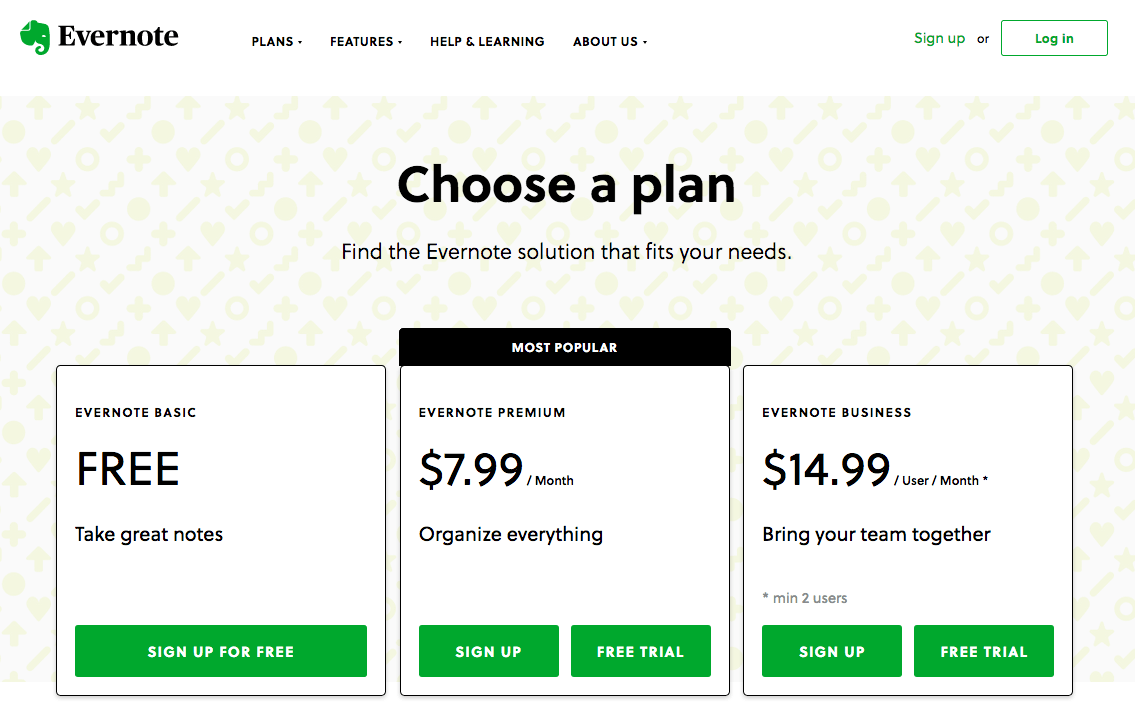
Freemium products are a great way to try out a new tool or app before committing to a subscription. Productivity tool Evernote, which first launched in 2004, is one of countless apps that come in a freemium version.
Evernote Premium, which the company introduced in 2011, was supposed to be a significant improvement on Evernote’s freemium version. It offered more features and more utility—for a price. Evernote has made several tweaks to its products and pricing over the years.
But is Evernote Premium worth it today?
That’s what we’ll be exploring in this post. We’ll look at exactly what an Evernote Premium subscription offers and what the key differences are between the free and Premium plans. We’ll also examine which types of users might benefit from an Evernote Premium subscription. Finally, we’ll be looking at Evernote Premium’s pricing and whether it’s still worth the cost.
What Does Evernote Premium Include?
In terms of functionality, Evernote Premium offers users almost everything that Evernote Business—Evernote’s costliest monthly plan—offers, with a few exceptions.
Evernote Premium can, of course, do everything that Evernote’s free version can do. But it’s not quite as fully featured as Evernote Business. Let’s take a look at the differences between Evernote’s freemium product and Evernote Premium, as well as the limitations of the Premium plan. Since all of Evernote’s plans include note-taking functionality, we’ve left that category out.
AI-Suggested Content
Over the years, Evernote has incorporated a range of artificial intelligence (AI) and machine-learning features to make the product “smarter” and more intuitive to use. Unfortunately, none of Evernote’s AI-suggested functionality is available in the freemium product.
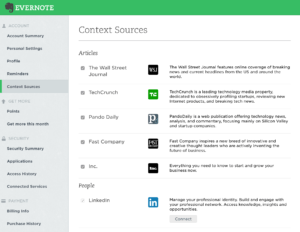
However, for Premium users, Evernote’s AI features, known as Evernote Context, can be a real time-saver. For example, Evernote can make personalized recommendations for related notes when creating new ones. This can help you avoid making duplicate notes and can make it easier to find relevant notes by their tags.
Evernote Premium’s AI functionality can also make content recommendations. Simply start typing a note and Evernote Premium can provide tailored suggestions for related content from leading publishers and news outlets from around the web, including Inc. Magazine and The Wall Street Journal.
Clipping and Capturing
One of Evernote’s handiest features is its Web Clipper. This tool allows you to “clip” and save practically anything you find online: articles, social media posts, ebooks, PDFs, images, videos, and more.
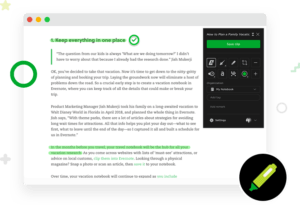
Evernote’s freemium version and its Premium plan offer identical clipping and capturing functionality. Both plans allow users to attach documents, files, PDFs, and receipts to notes, and both can clip full pages, text, and images from the web.
Evernote Premium allows users to forward emails directly to their Evernote account. Freemium users cannot do this. Evernote Premium also allows users to create contacts from scanned business cards, while Evernote’s free product does not. Finally, Evernote Premium users can annotate PDFs, whereas Evernote’s freemium version cannot.
Integrations
Evernote’s original core value proposition was to help users “remember everything.” As such, Evernote’s integrations play an important role in making the product more useful.
Evernote freemium users may be disappointed to learn that the free product doesn’t offer any external integrations whatsoever. This might not be the biggest deal if you just need a simple note-taking app. But if you’re hoping to make Evernote a central part of your daily workflow, you’ll need to upgrade to Evernote Premium.
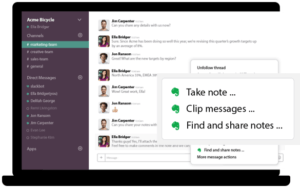
Evernote Premium, on the other hand, integrates with many of the most widely used productivity tools on the market. Evernote Premium users can link to Google Drive files within notes and Notebooks and can also connect an Evernote account to a Microsoft Outlook account. Evernote Premium also integrates seamlessly with Slack and Microsoft Teams. It doesn’t, however, offer integration with popular CRM Salesforce; you’ll need an Evernote Business subscription if you need Salesforce connectivity.
Organization
There’s little point in taking notes if you can’t organize them in a way that makes sense and makes it easy to find them later.
When it comes to keeping your stuff organized, all three Evernote plans are fairly similar. All three plans allow you to search notes; create new Notebooks and tags; organize notes by date, tag, or title; and search for text within images. For most users, this will probably be enough.

Unfortunately, Evernote’s freemium product does not allow you to search for text strings in PDFs and Microsoft Office documents. Unlike the Premium plan, the free product doesn’t allow you to access a revision history for your notes, either.
Sharing
Evernote’s free version allows you to share Notebooks with one or more people. You can also control who can access which notes by adjusting permissions controls in the freemium version, too. There probably aren’t too many use cases that rely on advanced permissions controls, but it’s handy that the freemium product offers them.
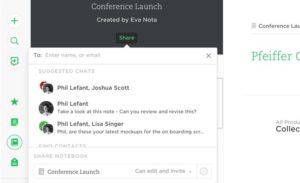
Evernote Premium doesn’t offer a great deal more than the freemium product. One notable exception is that Evernote Premium gives you the option to turn notes into a presentation with just one click, a feature lacking from the free product.
Team Administration & Collaboration
One of Evernote’s biggest challenges of the past several years has been how to make Evernote useful for individual users and teams. Despite introducing Evernote Spaces, Evernote’s Slack-like collaborative workspace tool, it hasn’t really figured this out yet.
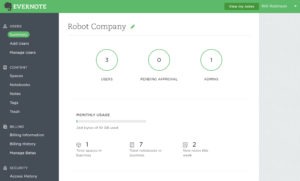
Unfortunately, neither Evernote’s freemium product nor Evernote Premium offers any team administration or collaboration tools at all. While this may serve as an incentive to upgrade to Evernote Business, it’s frustrating that Evernote doesn’t offer any collaboration tools to Premium subscribers.
Evernote Premium Pricing
Now that we’ve covered exactly what Evernote Premium can do, it’s time to talk pricing.
Evernote Premium costs $7.99 per month. Generally speaking, that isn’t unreasonable for a SaaS productivity tool. However, that applies only if we look at Evernote Premium in a vacuum. When you start comparing Evernote Premium to competing products on the market, it gets harder and harder to justify paying even $7.99 per month.
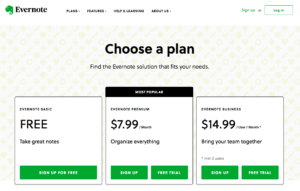
As we noted in our overview of Evernote competitors, many of the tools vying to replace Evernote can do everything Evernote can do, and at a fraction of the cost or even completely free.
Bear, a minimal note-taking app, offers a freemium version that can do almost everything Evernote can do. Similarly, workspace tool Notion can perform a lot of the same tasks as Evernote Premium, without having to pay for a subscription. Comparing Notion to Evernote might not be an apples-to-apples comparison, as we noted in our breakdown of the two tools, but it’s still very difficult to recommend Evernote over Notion, especially when it comes to price.
There’s nothing “wrong” with Evernote Premium’s pricing. It’s just very hard to justify paying $7.99 per month when there are so many tools that do the same things much more inexpensively.
Should You Choose Evernote Premium?
Evernote Premium is a capable tool that offers plenty of helpful features. However, whether Evernote Premium is right for you depends on your needs and budget.
In terms of pure functionality, most of Evernote Premium’s features are nice-to-haves rather than essentials. Its AI-suggested content recommendations, for example, are handy but are far from mission critical for most users. The fact that Evernote Premium doesn’t offer any team management or collaboration tools may be a deal-breaker for some users.
For simple note-taking and organization, Evernote’s freemium product will probably be perfectly fine for most users. Even then, an alternative like Bear may be a better fit. This is what makes Evernote’s Premium product so frustrating. It’s hard enough to justify paying for Evernote Premium as an individual, and the fact that Premium offers absolutely no collaborative features makes it even harder. Evernote Premium isn’t really worth it for individuals, and it doesn’t even work for teams.
Perhaps the only thing more difficult than justifying Evernote Premium’s price is figuring out who it’s supposed to be for.
Evernote Premium: Too Much for Too Little
If you’re a hardcore Evernote user, you probably don’t need to be sold on Evernote Premium. You’re either using it already or happily making notes in Evernote’s freemium product. Likewise, if you’ve been using Evernote’s free product for some time, upgrading to take advantage of Premium’s additional features might make sense for you.
That said, it’s a real shame how Evernote has lost its way in recent years. What used to be the undisputed king of note-taking apps has gradually been undercut and overshadowed by the many competing products that offer much more for far less.
It’s entirely possible that Evernote will reexamine the pricing and features included in Evernote Premium in the future. Until then, however, we’d recommend looking elsewhere.

